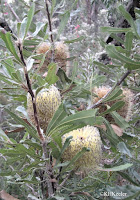Australian plants are justly famous for being diverse and often unique.
It was October, spring in the Southern Hemisphere.
 |
| banksias |
 |
| mountain devil, Lambertia formosa |
 |
| mountain devil |
Here the pink pea combines with a white flower. How lovely! The white may be a heath, family Ericaceae, but there are many genera, none of them familiar to me, so I will leave it at that.
This yellow flower is the broad-leaved drumstick, Isopogon anemonifolius, protea family, Proteaceae, same species as at the top of this post.
 |
| brand-leaved drumstick, Isopogon anemonifolius |
 |
| bottlebrush, Callistemon |
But look, beautiful gum trees (Eucalyptus)
The major continents separated north/ south when dinosaurs walked the earth, 200 million years ago. Australia, part of the southern group, became separated from South America, Africa and southern Asia about 180 million years ago. (maps) Consequently, Australia's plants and animals have been isolated from the other continents for millions and millions of years, long enough to evolve quite different species--kangaroos and koalas, for example. The same is true on the plant side. The Proteaceae, to which three of the plants above belong, is a Southern Hemisphere-only family, believed to have originated in Australia and consequently is most diverse and numerous there. The family Myrtaceae features gums/eucalyptus is also believed to have first evolved in Australia. Gum trees are almost entirely confined to Australia (700 species in Australia, about 15 in surrounding areas). There are lots of other enemic species and genera, the question for native plants is really more: what does Australia share with the rest of the world? than what is unique to Australia? There are over 20,000 plant species native to Australia: I was excited to see easily-recognized, iconic plants in their native land, but I barely began to comprehend the plant diversity there.
 |
| Seen in the Red Centre of Australia, Grevellia eriostachya |
 |
Giant spear lily, rare eastern Australian plant (see comment) growing in the Royal Botanic Gardens in Melbourne |
Comments and corrections welcome.
References
Cronin, L. 2008. Cronin's Key Guide: Australian Wildflowers. Jacana Books, Crows Nest, NSW, Australia.
Hope, C. and S. Parish. 2008. A Wild Australia Guide: Native Plants. Steve Parish Publishing, Archerfield, Queensland, Australia.
Waratah Software. 2018. Plant id: Alan and Diane Present Natural Images of Australia. Blue Mountain Wildflowers Accessed 1/12/18 link
Kathy Keeler, A Wandering Botanist
More at awanderingbotanist.com
Join me on Facebook: https://www.facebook.com/AWanderingBotanist
You might also like these posts:
Victoria, Australia link

Kakadu National Park, Northern Territory, Australia link

You might also like these posts:
Victoria, Australia link

Kakadu National Park, Northern Territory, Australia link







Lovely to read about our native flora. I just wanted to clarify that the image you have labelled a kangaroo paw is actually Doryanthes Palmeri. Thank you for your botanical wanderings :)
ReplyDeleteThank you for the correction! I fixed the post.
Delete